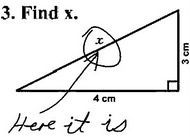The schools ain't what they used to be
In response to Education Wonk's Many Young Adults In The U.S. Can't Find "X" On A Map article, a friend in educational leadership sent me a short article by Richard Rothstein: The Way We Were? The Myths and Realities of America's Student Achievement in which I found the following tidbits.
Assistant Education Secretary David Kearns warns: "public education has put this country at a terrible competitive disadvantage ... If current trends continue, American business will have to hire a million new workers a year who can’t read, write or count." "The vast majority of Americans," says Education Secretary Richard Riley, "do not know that they do not have the skills to earn a living in our increasingly technological society and international marketplace."
But, asks Rothstein, when was the golden age to which our age should be compared?
The 1960s and 1970s
- In 1974, Vance Packard asked: "Are we becoming a nation of illiterates? [There is an] evident sag in both writing and reading ... at a time when the complexity of our institutions calls for ever-higher literacy just to function effectively." He warned: "there is indisputable evidence that millions of presumably educated Americans can neither read nor write at satisfactory levels."
- The 1961 report Tomorrow’s Illiterates: The State of Reading Instruction Today claimed a third of ninth graders could read at only a second or third grade level because phonics had been abandoned.
The 1950s
- In 1958 Hannah Arendt warned that academic standards "of the average American school lag ... far behind the average standards in ... Europe." Historian Arthur Bestor complained that physics, chemistry, and mathematics were now "taught to a shrinking proportion of students"
- A 1955 best-seller, Rudolf Flesch’s Why Johnny Can’t Read (reissued in 1986), warned that refusal to use phonics "is gradually destroying democracy in this country; it returns to the upper middle class the privileges that public education was supposed to distribute evenly..."
- In 1951 a proficiency test given to Los Angeles eighth graders found more than half could not calculate 8% sales tax on an $8 purchase. Local newspapers made another shocking disclosure: "330 of L.A. High Schools’ Juniors Can’t Tell Time."
The 1940s
- In a 1940s survey, business executives said recent graduates were greatly inferior to the previous generation in arithmetic, written English, spelling, geography, and world affairs. In only one domain were recent graduates deemed superior: "poise."
- In 1947 Benjamin Fine declared in his book, Our Children Are Cheated: "Education faces a serious crisis ... We will suffer the consequences of our present neglect of education a generation hence."
- Talking about airline reservation clerks hired during World War II, a corporate training director complained he had to "organize special classes to instruct them in ... making change ... Only a small proportion [can] place Boston, New York, ... Chicago, ... Denver ... in their proper sequence from east to west, or name the states in which they [are located]."
- In 1943, the New York Times administered a social studies test to 7,000 college freshmen nationwide. Only 29 percent knew St. Louis was located on the Mississippi; only 6 percent knew the thirteen original states of the Union. Some thought Lincoln was the first president. The results, the Times reported, revealed a "striking ignorance of even the most elementary aspects of United States history."
World War I through the 1930s
- A 1938 study of first-grade classes stated: "teachers ... conspire against pupils in their efforts to learn; these teachers appear to be determinedly on guard never to mention a letter by name ... or to show how to use either letter forms or sounds in reading."
- In the 1920s, business leaders reported with dismay that job seekers no longer had adequate educational preparation. The National Association of Manufacturers charged in 1927 that 40 percent of high school graduates could not perform simple arithmetic or accurately express themselves in English.
- In 1913 Woodrow Wilson appointed a commission to study vocational education; its discovery that the US had fewer vocational schools than Bavaria mobilized support for the Smith-Hughes Act of 1917, the first federal "voc-ed" legislation.
- More than half the young men recruited by the army during World War I "were not able to write a simple letter or read a newspaper with ease."
The Early 1900s
- In 1909, Ellwood P. Cubberly, dean of Stanford’s education school, wrote: "whether we like it or not, we are beginning to see that we are pitted against the world in a gigantic battle of brains and skill." His book, Changing Conceptions of Education, warned that Americans were lagging in this contest.
- In 1902, the New York Sun recalled that when they had attended school, children "had to do a little work ... Spelling, writing and arithmetic were not electives, and you had to learn." Now, however, schooling was "a vaudeville show. The child must be kept amused and learns what he pleases."
- An Atlantic Monthly article of 1909 complained that basic skills instruction had been displaced in schools by "every fad and fancy" and noted that the curriculum resembled "the menu card of a metropolitan restaurant."
The Nineteenth Century
- Harvard’s Board of Overseers published bad samples of freshman writing to embarrass secondary schools in 1896. The report's author wrote there was "no conceivable justification for using the revenues of Harvard College" to instruct undergraduates who were unprepared for college work. Another overseers’ report, five years earlier, had found that only 4 percent of students who applied for Harvard admission could write an essay, spell, or properly punctuate a sentence.
- An 1898 writing exam at the University of California (Berkeley) found that 30-40% of entering freshmen were not proficient in English.
- In 1845 America’s first standardized test was administered to a group of Boston’s brightest students (called "brag scholars" by the testing committee). Only 45 percent of these top fourteen-year-olds knew that water expands when it freezes.
According to Horace Mann, Boston’s schools of the 1840s were ignoring higher-order thinking skills; what little students knew came from memorizing "words of the textbook ... without having ... to think about the meaning of what they have learned." Thus, 35 percent knew from history classes that, prior to the War of 1812, the United States had imposed an embargo on British and French shipping, but few had any clue what "embargo" meant. In one school, 75 percent of the students knew the date of the embargo, but only 5 percent could define the term.
In conclusion, Rothstein paraphrases Will Rogers: "The schools ain’t what they used to be and probably never were."
Technorati Tags: Education, History, America



 A few of my daughter
Melina's great posts:
A few of my daughter
Melina's great posts:








0 Comments:
Post a Comment
<< Home